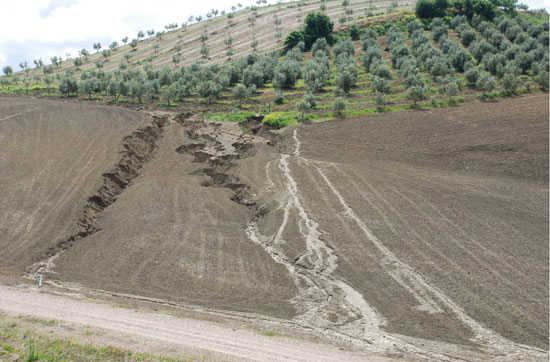Desertification has been defined as "the degradation of lands in arid, semi-arid and dry sub-humid areas resulting from various factors including climatic variations and human activities". The definition of the United Nation Convention to Combat Desertification (UNCCD) suffers from its lack of precision (Barbero-Sierra, Margues & Ruis-Perrez, 2013).
Is what we call desertification comparable to the quick shift of the Sahara from green to desert 6000 years ago, at the mid-Holocene? This change resulted from the change of the earth orbit which moved southward the ITCZ and the monsoon (Blom et al. 2004). It is important to grade the desertification. Nevertheless, if the SLR can be assessed easily by comparing the absolute SLR and the subsidence of the continent, the definition of the desertification does not implies a clear assessment.
 |
| When the soils loose their fertility |
What is the degradation of lands? Bestelmeyer (2005) considers the shift from grasslands to shrublands as a desertification. However the author does not link it to a drop of the diversity. However he underlines the effects on the agricultural production. Indeed, the livestock needs grasslands. Is it the degradation of lands a drop of the agro-pastoral capacities of the soils? In India after the green revolution, the growth of irrigated lands which lead to a salinization of the soils and a loss of their fertility, many authors have pointed the risks of desertification.
Which human activities lead to desertification? Of course, the intensive agriculture which does not consider the needs of the soils affects their fertility. As long as the agriculture, pick out of the ground more than it can sustain, the fertility of the soils will decrease. Barbero-Sierra, Margues & Ruis-Perrez (2013) also consider the sprawl urbanization as a cause of desertification by sealing the grounds and by converting the agricultural fields in low density urban areas.
 |
| The danger of intensive agriculture in Spain |
The climate change causes of the desertification are easier to understand. An arridification, a drop of the precipitation etc.
Veron et al. (2006) assessed the desertification thanks to many indicators relative to the plant cover, the erosion, the salinization. However Barbero-Sierra, Margues & Ruis-Perrez (2013) state that the reversibility of the desertification has to be assessed to understand the threats on the population and on the biodiversity and to get a better idea of the necessary actions to reverse the process. The intensity of the factors shows immediately the reversibility of the process. Some actions could be taken on some target areas where the results could be more successful.
Barbero-Sierra, C. Margues, M.J. & Ruis-Perrez, M. 2013.The case of urban sprawl in Spain as an active and irreversible driving force for desertification. Journal of Arid environments. Vol. 90. p95-102. http://www.sciencedirect.com/science/article/pii/S0140196312002820
Bestelmeyer, B.T. 2005. Does desertification diminish biodiversity? Enhancement of ant diversity by shrub invasion in southwestern USA. Diversity and Distribution. No.11. p45-55
Blom et al. 2004. The Green Sahara: Climate Change, Hydrologic History and Human Occupation.
http://ieeexplore.ieee.org/stamp/stamp.jsp?tp=&arnumber=4977129
Veron, S.R. Paruelo, J.M., Oesterheld, M. 2006. Assessing desertification. Journal of Arid environments. No. 66. p 751-763
Veron et al. (2006) assessed the desertification thanks to many indicators relative to the plant cover, the erosion, the salinization. However Barbero-Sierra, Margues & Ruis-Perrez (2013) state that the reversibility of the desertification has to be assessed to understand the threats on the population and on the biodiversity and to get a better idea of the necessary actions to reverse the process. The intensity of the factors shows immediately the reversibility of the process. Some actions could be taken on some target areas where the results could be more successful.
Barbero-Sierra, C. Margues, M.J. & Ruis-Perrez, M. 2013.The case of urban sprawl in Spain as an active and irreversible driving force for desertification. Journal of Arid environments. Vol. 90. p95-102. http://www.sciencedirect.com/science/article/pii/S0140196312002820
Bestelmeyer, B.T. 2005. Does desertification diminish biodiversity? Enhancement of ant diversity by shrub invasion in southwestern USA. Diversity and Distribution. No.11. p45-55
Blom et al. 2004. The Green Sahara: Climate Change, Hydrologic History and Human Occupation.
http://ieeexplore.ieee.org/stamp/stamp.jsp?tp=&arnumber=4977129
Veron, S.R. Paruelo, J.M., Oesterheld, M. 2006. Assessing desertification. Journal of Arid environments. No. 66. p 751-763
Aucun commentaire:
Enregistrer un commentaire